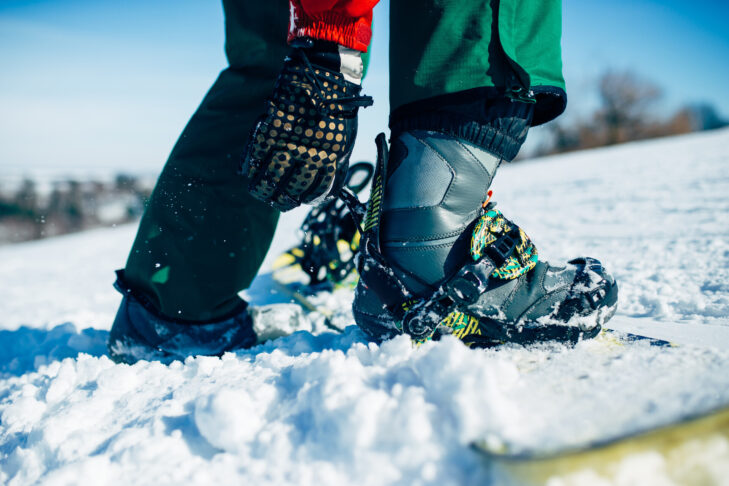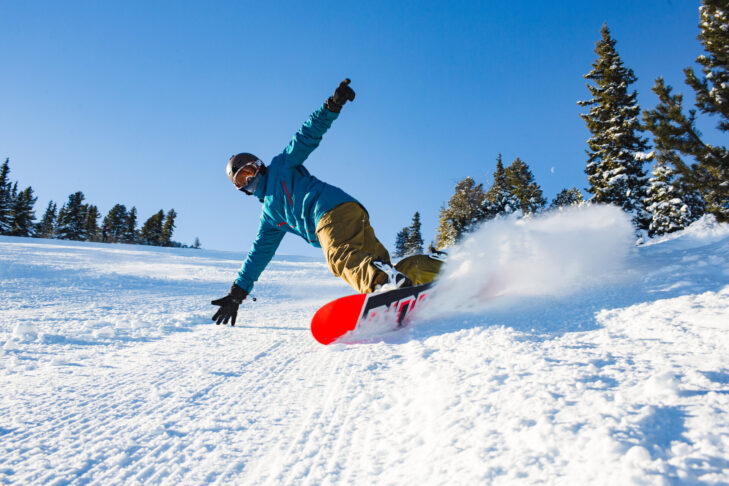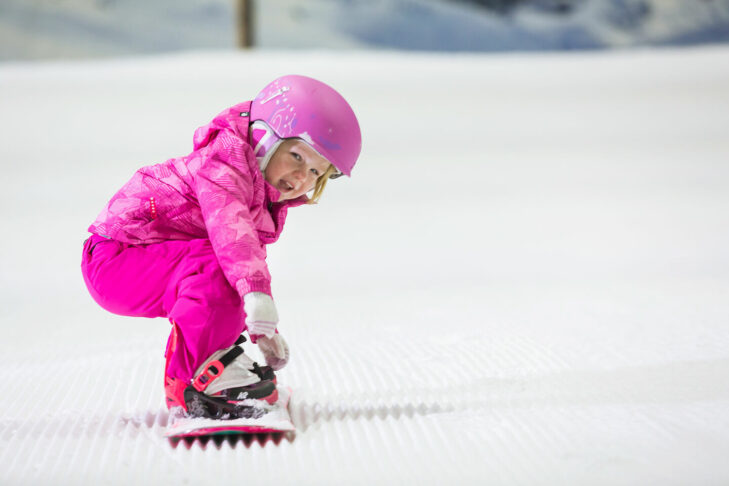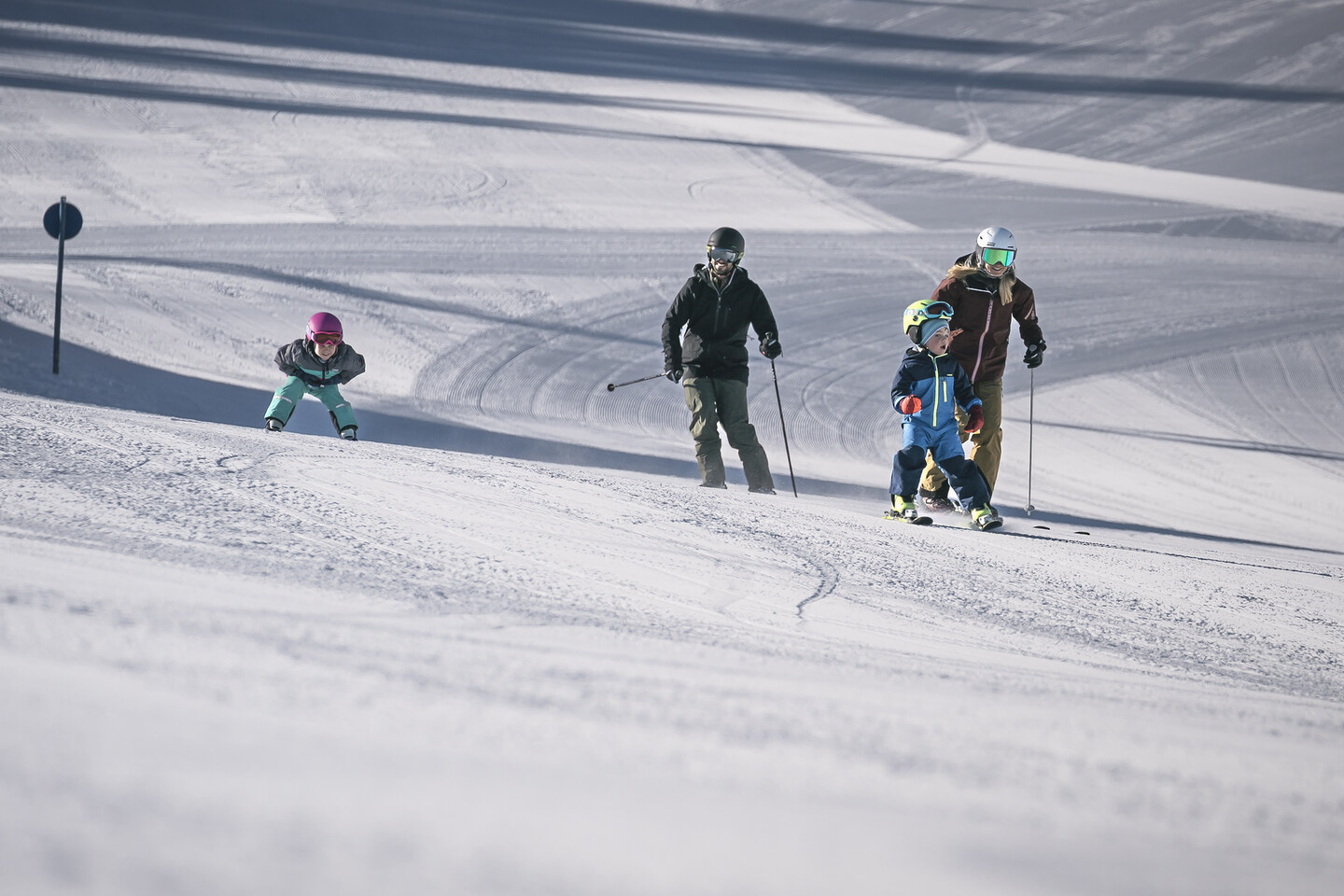Controlled carving turns on the piste or churning up powder while freeriding. Winter sports enthusiasts who want to experience these feelings on a snowboard need one thing above all: control. The most important “tool” for this is the snowboard boots. They create the connection between your feet and the board. But for things to go right on the mountain, body and boot must almost form a unit. That’s why choosing the right snowboard boots is so important. In this compact snowboard boot guide, SnowTrex explains what is important and what beginners and advanced snowboarders should consider before buying.
What the perfect snowboard boot must be able to do
It’s all a question of ability. What applies to many areas of life is also crucial when choosing the perfect snowboard boots. As with boards, there are different models of boots for every terrain and therefore for every ability level. Beginners are best advised to go for classic beginner boots. These keep you warm thanks to their lining, the upper material is softer and the lacing is simple and easy to adjust. Thanks to the flexibility of snowboard boots, winter sports enthusiasts can bend their knees better, which enables better control of the board. For advanced snowboarders, on the other hand, there is no way around an all-mountain boot when choosing a snowboard boot. As the name suggests, unlike beginner boots, they are suitable for any terrain. They are soft enough to cushion jumps in the snow park, but also stiff enough to really pick up speed on the piste.
Freestyle boots are a little more specialised. Snowboarders who grind over rails and jump kickers on the mountain get a boot that is very soft in terms of material and therefore better absorbs the energy of hard hits. In addition, these models often have additional shock-absorbing materials incorporated into the heel and sole. Experienced snowboarders who feel most comfortable in deep snow away from the piste need freeride boots. In the backcountry in deep and soft powder, stability is the most important thing, which is exactly what this material offers. In addition, the outer boots and the heel and toe area are reinforced with robust materials.
In addition to the general construction of snowboard boots for different types of terrain such as piste or snow park, the boots, like ski boots, differ in their “flex”. This value between 1 and 10 indicates how easily the material can be bent. The following applies: the softer the flex, the more beginner-friendly the boot is.
“Soft” snowboard boots for beginners, hard ones for pros
Overall, the flex scale is divided into the following areas: soft, medium and stiff. Soft snowboard boots have a flex of 1 to 4. As the flexibility of the material allows maximum control over the board with relatively little effort, they are ideal for beginners. But freestylers also appreciate the light flex, as it has a cushioning effect when landing after jumps and tricks. Boots with a value between 4 and 7 fall into the “medium” category. They are very popular with experienced hobby riders, as all-mountain boots in particular have this flex. Snowboard boots with a flex between 7 and 10 offer the least freedom of movement and are only suitable for real professional boarders, as their stiff construction provides a lot of stability and manoeuvrability at high speeds and in soft deep snow.
All these models are available for every type of binding. For example, manufacturers offer snowboard boots for both click and flow bindings. Or for separable splitboards for touring, which are a mixture of soft and hard boots. For the descent, the shaft can be attached to the back of the heel, while this part of the snowboard boot can be detached for the ascent to allow a natural walking motion. But no matter which type of snowboard boot winter sports enthusiasts ultimately choose, they all fall within a certain price range. The cheapest boots are available for as little as 43 pounds, while the most expensive cost up to 550 pounds! Most new, high-quality snowboard boots from well-known manufacturers, on the other hand, cost between 220 and 305 pounds.
Lace or strap snowboard boots?
In contrast to ski boots, which with their hard plastic outer shell are really only suitable for the piste or après-ski, snowboard boots are more like normal shoes. This is also due to the fact that the traditional type of fastening is reminiscent of trainers or winter boots. After all, most special shoes for snowboarders have classic laces. The only difference to street shoes is the length and the more robust construction. Otherwise, these snowboard boots are very easy to lace up, which makes it easier to adjust them depending on whether the snowboarder prefers to wear their boots tighter or wider. This lacing system is ideal for children in particular, as they can quickly adjust their snowboard boots if they have problems riding or don’t feel comfortable with the material.
However, as is the case with any technology, snowboard boots have also developed over the years – both in terms of material and fastening. In addition to laces, there are now also so-called speed lacing and “BOA” systems.
Fast, faster, speed lacing
Speed Lacing is a system that consists of thin nylon straps and a “puller”. The straps are divided into two zones, one on the back of the foot and one on the shin, where they are crossed like laces. However, they do not need to be tied so that the snowboarder can simply slip their foot into the boot. They are then pulled together and closed at the top of the boot tongue with the “puller”, a plastic guide mechanism through which the nylon straps are guided and then locked in place.
The latest development in closing snowboard boots is the “BOA” system. Here too, the laces are fastened using nylon straps, but these are tightened using twist fasteners. As with speed lacing boots, winter sports enthusiasts can simply step into the boot with their foot. To close the boot, they then attach the straps and a Velcro fastener to the shin and turn the wheel on the outer tongue of the snowboard boot clockwise. The whole system then tightens. There are now also double and triple “BOA” systems that have a second or third twist lock. These are located on the outside and/or inside of the boot shaft and ensure an even better hold of the foot in the snowboard boot.
Find the right snowboard boot
In order to find the right fit for snowboard boots and how tight, narrow or large they are best, winter sports enthusiasts first need to know what boot size they need. The easiest way to do this is to measure the length of your foot in centimetres. The result can then be precisely assigned to a Mondopoint size. To obtain an exact measurement, the larger of the two feet should be placed with the heel against a wall and then measured with a tape measure up to the tip of the big toe. In order to be able to assign your own Mondopoint to a specific boot size, winter sports enthusiasts should use a corresponding size chart for snowboard boots as a guide. As the boots are usually only given in US sizes, we have also assigned them to the corresponding EU shoe sizes in the following list:
| Foot Length in Centimeters (cm) | Men's US Shoe Size | Women's US Shoe Size | EU Shoe Size |
|---|---|---|---|
| 22 | 4 | 4.5 | 34.5 |
| 22.5 | 4.5 | 5 | 35 |
| 23 | 5 | 5.5 | 36 |
| 23.5 | 5.5 | 6 | 36.5 |
| 24 | 6 | 6.5 | 37 |
| 24.5 | 6.5 | 7 | 38 |
| 25 | 7 | 7.5 | 38.5 |
| 25.5 | 7.5 | 8 | 39 |
| 26 | 8 | 8.5 | 40 |
| 26.5 | 8.5 | 9 | 40.5 |
| 27 | 9 | 9.5 | 41 |
| 27.5 | 9.5 | 10 | 42 |
| 28 | 10 | 10.5 | 42.5 |
| 28.5 | 10.5 | 11 | 43 |
| 29 | 11 | - | 44 |
| 29.5 | 11.5 | - | 44.5 |
| 30 | 12 | - | 45 |
| 30.5 | 12.5 | - | 46 |
| 31 | 13 | - | 46.5 |
| 31.5 | 13.5 | - | 47 |
| 32 | 14 | - | 48 |
| 32.5 | 14.5 | - | 48.5 |
| 33 | 15 | - | 49 |
So far, so good. Because once you’ve found the right snowboard boot in terms of size, that doesn’t mean you can go straight onto the piste. Because the fit of the boots is also crucial.
What else to consider when choosing a snowboard boot
When you first get into your boots, the material may still feel tight and may even pinch. As with ski boots, it is normal for the toes to touch the tip of the boot slightly at the front. The inner boot must then be laced tightly so that the heel slides into the heel pocket, which in turn reduces the pressure on the toes and makes the fit more comfortable. If the snowboard boot still feels tight afterwards, this is a good sign on the one hand, as a firm fit over the entire foot is essential for optimum control of the board on the piste. On the other hand, unpleasant pressure points should be avoided at all costs. To improve the fit, snowboard boots should therefore be broken in for a few hours. This allows the padding material of the inner boot to mould to the foot through body heat.
The following video shows how winter sports enthusiasts can find the right size of snowboard boots:
Please also note that by using our services and integrating the YouTube API Services, the YouTube Terms of Service and the YouTube API Services Terms apply and your use of our website is deemed to be acceptance of these terms.
And finally, when it comes to fit, one thing should not be underestimated or even forgotten: the ski or snowboard socks. Because without these “textile overcoats”, no snowboard boot will fit properly. When choosing the right socks, it is advisable to go for socks made from merino wool or synthetic fibres. These materials simply protect and warm your feet best. Under no circumstances should you wear two pairs of socks on top of each other or socks that are too big. These can slip in the shoe, form creases and lead to unwanted pressure points or even blisters. To avoid this, insoles can also help, which can heat the snowboard boots with an in-built heater that can be powered by battery or USB.
Snowboard boots need to be well looked after
If you want to buy snowboard boots, you can of course do this online or in a sports shop with the right tips. The staff there can help with personalised advice on snowboard boots.
After the purchase, you can finally hit the piste. But after a long day in the wet and cold snow, winter sports enthusiasts need to pay attention to another important detail: the care of their snowboard boots. Although they are waterproof, they need to be dried after hours of use on the mountain, as the reduced breathability of the material due to the physical exertion can lead to heavy foot perspiration. The property of not allowing water to penetrate the shoes also means that it is difficult for moisture to escape. The most effective method of drying is to use a ski boot dryer, which is also suitable for snowboard boots. If such devices – usually free of charge – are not available free of charge in the ski cellar of the hotel or chalet in the ski resort, the boots can also be dried overnight on or next to the room heating.
To combat unpleasant odours in the short term, boot cleaning sprays or boot deodorants can also be used. It is also advisable to always wear freshly washed socks in your snowboard boots. Models with removable inner shoes should also be washed thoroughly by hand after the winter season instead of machine washing. This way, damage caused by the spin cycle can be avoided. To avoid scratches on the upper material, it is also advisable to remove snow residue from the boots with a broom at the end of a day’s skiing. This applies in particular to heavily used soles. It is mainly stones and road salt residue that should be carefully removed, as the latter can be particularly corrosive to synthetic materials.
FAQ about snowboard boots
How big should snowboard boots be?
As with normal street shoes, it naturally depends on the size of the winter sports enthusiast’s shoes. Snowboard boots are measured according to Mondopoint, i.e. the actual length of the foot from the heel to the tip of the big toe in centimetres. The shoe size is then given in US measurements, but these can easily be converted into EU shoe sizes using a size chart for snowboard boots.
How much do snowboard boots cost?
What applies to most winter sports equipment also applies to snowboard boots. The price range is wide. The cheapest snowboard boots cost just over 40 pounds, while the most expensive models can cost up to 550 pounds. The price for the latest and therefore highest quality snowboard boots from well-known manufacturers is generally between 220 and 305 pounds.
Which snowboard boots are the right ones?
There is no concrete answer to this question. Snowboard boots need to take the individuality of the wearer into account. In other words: how well can they snowboard, what terrain do they want to do it on and what size feet do they have? Every snowboarder has to answer these questions themselves in order to find THE “right” snowboard boots for them.
What should you look out for in snowboard boots?
In addition to the right size and optimum fit, snowboard boots need to be selected according to where the winter sports enthusiast wants to ride and how well they can snowboard. Depending on the level of riding ability, the boots are categorised on a flex scale from 1 to 10, which describes their flexibility. Models between 1 and 4 are “soft” and ideal for beginners, while 4 to 7 describe the “medium” category. These boots are more suitable for advanced skiers, while a flex of 7 to 10 is considered “hard” and is only suitable for professionals. Snowboard boots are also categorised into four model groups: Beginner boots, all-mountain boots, freestyle boots and freeride boots.
How should snowboard boots fit?
Snowboard boots should always fit a little tighter at the beginning, as the material of the inner boot adapts to the wearer’s foot over time and through body heat. They should therefore not be too loose. As with ski boots, it is normal for the toes of snowboard boots to touch the tip of the boot slightly at first.
Is snowboarding possible without snowboard boots?
Firstly, snowboard boots are designed to fit perfectly into the snowboard binding. Winter sports enthusiasts could also try to get into the snowboard binding with normal winter boots. But the whole system is safety-relevant on the piste, so street shoes on a snowboard are an absolute no-go!





